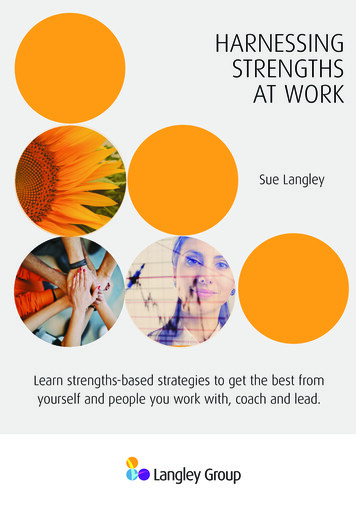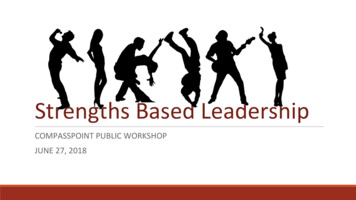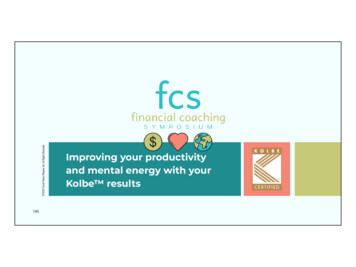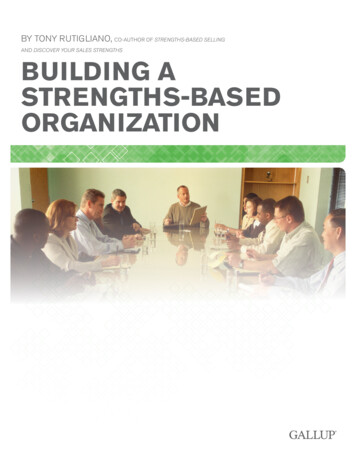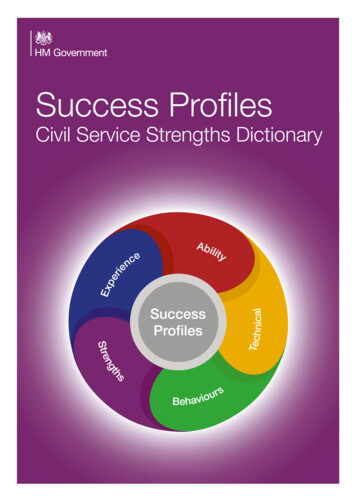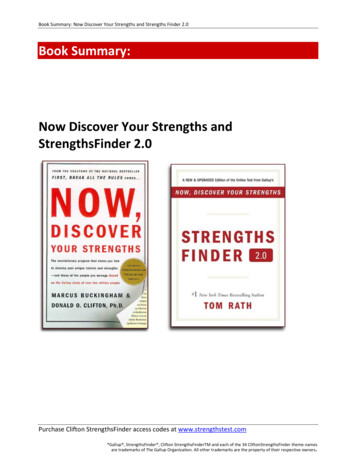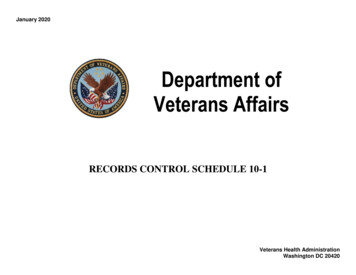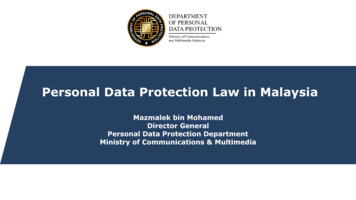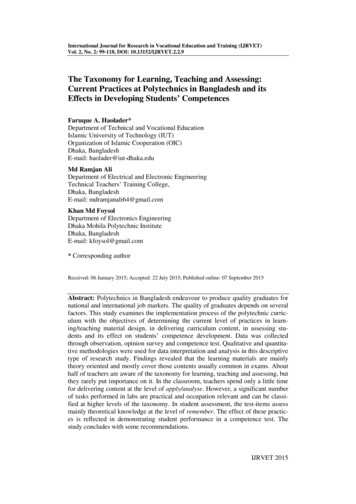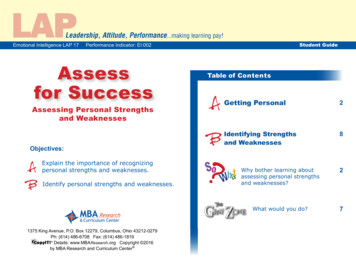
Transcription
LAPLeadership, Attitude, Performance.making learning pay!Emotional Intelligence LAP 17Performance Indicator: EI:002Assessfor SuccessAssessing Personal Strengthsand WeaknessesObjectives:Explain the importance of recognizingpersonal strengths and weaknesses.Identify personal strengths and weaknesses.Student GuideTable of ContentsGetting Personal2Identifying Strengthsand Weaknesses8Why bother learning aboutassessing personal strengthsand weaknesses?2What would you do?71375 King Avenue, P.O. Box 12279, Columbus, Ohio 43212-0279Ph: (614) 486-6708 Fax: (614) 486-1819Details: www.MBAResearch.org Copyright 2016by MBA Research and Curriculum Center LAP-EI-017-PQ 2016, MBA Research and Curriculum Center Assess for Success1
Getting PersonalPhilip is an excellent writer who’s at his best when he can collaborateand share ideas with team members. What will happen if Philip takes aHave you everjob that is math-oriented and requires working alone all day? Most likely,interviewed for aPhilip will be unhappy and unsuccessful.job and faced thesequestions:His managers and coworkers will also be frustrated with his performance. Philip needs to be in a position that capitalizes on his strengths What is your greatest strength?and minimizes his weaknesses. But, for this to happen, he needs to What is your greatest weakness?know what those strengths and weaknesses are!Perhaps you don’t have a lot of interviewexperience yet, but be assured that you willhave to answer these questions in the future.Interviewers use them to determine whetheror not you are a good fit for a certain position. You want a job that uses your strengthsployers want this as well. An employee in thewrong job is a waste of time and effort foreveryone involved. This is why developingthe ability to identify your personal strengthsand weaknesses is so important. Read on tolearn more about how you can master thisHongqi Zhang/iStock/Thinkstockand minimizes your weaknesses—and em-vital skill!How can you find a career that’s the best fit for you? First,you have to assess your own strengths and weaknesses.LAP-EI-017-PQ 2016, MBA Research and Curriculum Center Assess for Success2
If you stop to think about it, we often assess, or evaluate, the strengths andweaknesses of everyday things. A coach, for example, might have the team assessthe strengths and weaknesses of its performance in yesterday’s game. You might askyour supervisor to look over your proposal to identify its strengths and weaknesses.Both cases should reveal things that were done well and things that need improvement. The same principle is true for people. We all have our own individual strengthsand weaknesses.“Know thyself”Socrates, an ancient Greek philosopher, said, “Know thyself.” His quote encouragesyou to evaluate yourself as a person. By doing this, you can make the best use of yourstrengths and can identify areas for improvement. In short, you can work to become abetter employee and a better you. Other benefits of knowing yourself include:Brigida Soriano/iStock/ThinkstockThe ability to apply your talents where they are best used. Once you understand what you do best, you can look for opportunities to apply those talents. Youmay have great interpersonal skills and be very persuasive. These strengths wouldtranslate well into a sales career. Or, you might be a very talented artist. This skillcould take you many places—a career in graphic design, art education, or even fashion. Knowing your strengths can also help you maximize your performance in yourcurrent job. Let’s say you’ll be babysitting all summer. If you have athletic talent, youcan take the kids swimming or to the park to learn how to play soccer. This will likelybring you more success and satisfaction than staying indoors playing video games.LAP-EI-017-PQ 2016, MBA Research and Curriculum Center Assess for Success3
If one of your strengths is being outgoing, what sort of careershould you have? What about if you’re caring, determined, or a greatleader? “What Are Your Strengths” from the University of Kent listssome possible career options for a variety of strengths. The link alsoCatherine Yeulet/iStock/Thinkstockincludes a strengths test: tm .Increased opportunities for professional development andcareer success. When you know your strengths and weaknesses,you have a greater chance for career success. You give yourself theopportunity to maximize your strengths and improve your weaknesses. Perhaps you’ll pursue a career in architecture, but there will be acertain software program you struggle with. When you recognize thisWhen you understand your weaknesses, you can take stepsto improve them by taking classes or seminars.weakness, you can take steps to fix it—spending extra time on it afterwork or taking a class or seminar, for instance. You can also utilizeyour strengths, possibly by mentoring coworkers in certain subjectsor taking the lead on an account you’ve had experience with.LAP-EI-017-PQ 2016, MBA Research and Curriculum Center Assess for Success4
Better interviewing skills. Asking a potential employee about his/her greateststrengths and weaknesses is a classic interview tactic, one that you will undoubtedlyface many times over the course of your career. As with all interview questions, it’sbest to have an answer reviewed and ready to go. When you have taken the timeto evaluate yourself and identify your strengths and weaknesses, you will be betterprepared to handle these questions. As a result, you will be a more impressive interviewee with a better shot at landing that job.It can be tough to talk to an interviewer about your weaknesses! This article byAlison Green, “How to Talk About Your Weaknesses in a Job Interview,” explains howyou can use your knowledge of your personal weaknesses to craft a great answerfor this tricky question: ses-in-a-job-interview .Better decision-making skills. Whether or not you realize it, you make choicesOrla/iStock/ThinkstockIs time management one of your weaknesses? Self-assessment can help youmake better time-management decisions!based on your personal strengths and weaknesses. Let’s say one of your weaknesses is time management. Time management involves many small decisions each day.If you are not a good manager of time, then many of those small decisions you makeare probably the wrong ones—going to bed too late or spending too much time on aminor project, for example. When you recognize this weakness, you can look at yourindividual decisions in a new light and begin making improvements .LAP-EI-017-PQ 2016, MBA Research and Curriculum Center Assess for Success5
Better teamwork skills. Groups need people with certain strengthsto function effectively. No one person can possess all these strengths.Therefore, a mix of different group members with different strengths isimportant. When group members know their strengths and weaknesses,they have a clear understanding of what they bring to the table to helpthe group succeed.Robert Churchill/iStock/ThinkstockThese are just a few of the benefits that identifying strengths andweaknesses can bring to your career. Can you think of even more?SummaryEveryone has strengths and weaknesses. In our careers, it’s importantto capitalize on our strengths and to minimize and improve our weaknesses. Benefits of identifying personal strengths and weaknessesinclude the ability to apply your talents where they are best used,increased opportunities for professional development and careerWhen you know your strengths and weaknesses,you’ll be a better team member.success, better interviewing skills, better decision-making skills,and better teamwork skills.LAP-EI-017-PQ 2016, MBA Research and Curriculum Center Assess for Success6
It’s often helpful to get input from others when assessingpersonal strengths and weaknesses. At one time or another,you may be the person someone comes to for input onhis/her self-assessment. Let’s say a friend from the officeasks for your feedback on his strengths and weaknesseson the job. You’ve thought of a few weaknesses as well asstrengths, but you’re unsure about sharing your thoughts.You value your friendship with him and don’t want tocause problems or hurt his feelings. On the other hand,knowing his weaknesses can help him improve andbecome a better employee. What should you do?1. How does self-assessmentof strengths and weaknesseshelp you to apply your talentsappropriately?2. How does self-assessmentof strengths and weaknessesprovide increased opportunitiesfor professional developmentand career success?3. How does self-assessment ofstrengths and weaknesses helpto build better interviewingskills?4. How does self-assessmentof strengths and weaknesseshelp to build better decisionmaking skills?5. How does self-assessmentof strengths and weaknesseshelp to build better teamworkskills?LAP-EI-017-PQ 2016, MBA Research and Curriculum Center Assess for Success7
IdentifyingStrengths and WeaknessesYou understand the benefits of identifying your personal strengthsand weaknesses and how doing so can help you build a moresuccessful career. But, how do you go about it? Identifying yourstrengths and weaknesses is not easy—in fact, it can be downrightscary. Self-examination may reveal characteristics we don’t reallylike about ourselves. Plus, some people have low self-esteem, sothey are much more aware of their weaknesses than their strengths.It takes courage to evaluate yourself, acknowledge your strengths,and examine your flaws.Take some tipsYour self-assessment will be more productive and balanced if youfollow these tips:Robert Churchill/iStock/ThinkstockBe realistic. It’s great to dream big, but you must also be honestwith yourself about your limitations. If you have a below-averageaptitude for and interest in math, you may not become a NASAengineer. You will need to pursue a career that’s better suited forThere are so many possible careers. Self-assessmentcan help you pursue the one that’s right for you!your strengths.LAP-EI-017-PQ 2016, MBA Research and Curriculum Center Assess for Success8
Don’t compare yourself to others. You might wish that you had your bestfriend’s math skills or your coworker’s public speaking ability, but remember—assessing your own strengths and weaknesses is not a competition. It involves onlyyou, so there is no need to compare. Everyone has abilities. You may not be a mathwhiz like your best friend, but maybe your strength is in learning foreign languages.And while you might not be a great public speaker like your coworker, maybe you’rebevangoldswain/iStock/Thinkstockgood at organizing team projects. All of these strengths have their own advantages!Be specific. Don’t just say, “I am a good leader,” or “I am not a good leader.”Think about what makes these statements true. Are you a good leader because youknow how to communicate clearly, and you don’t shy away from responsibility? Areyou a poor leader because you lack self-confidence? Break down general statementsto get to the heart of your strengths and weaknesses.Be honest. Of course, it’s difficult sometimes to admit a weakness. No one likesto look at him/herself and see flaws. Keep in mind that no one is perfect, and everyone has areas that need improvement. If you’re not honest about your weaknesses,It can be hard to examine your flaws, butit’s necessary to reflect on your weaknessesas well as your strengths.you won’t have the opportunity to improve them. On the flip side, it’s sometimesdifficult to be honest about strengths as well. We don’t want to seem as if we’rebragging or stuck up. Be assured that recognizing our talents, abilities, and thethings we do well is a healthy and acceptable thing to do!LAP-EI-017-PQ 2016, MBA Research and Curriculum Center Assess for Success9
Don’t be too hard on yourself. Recognizing our weaknesses is important, butit’s equally important that we don’t obsess over them. Remember, beating yourself up over your weaknesses won’t help you improve! Try to identify one strengthfor every weakness you find in yourself.Don’t make false generalizations. Never base your idea of a personalstrength or weakness on one isolated incident. Missing one deadline does notmake you a poor time manager. Acing one test does not make you a genius,Triloks/iStock/Thinkstockeither! Look for patterns in your behaviors, things that occur regularly over time,before you decide what’s a strength and what’s a weakness.Assess yourself on a regular basis. Have you kept a portfolio of importantdocuments and projects from throughout your educational and professionalcareer? Once in a while, you may look over these items. Some things are stillvaluable to you, while others are not. If you compare a paper you wrote fiveyears ago to one you wrote yesterday, it is obvious that your abilities haveAssess your strengths and weaknesses on aregular basis!improved. Assessing your strengths and weaknesses is similar to this process.You should start your assessment early in your career, but you need to reviewyour strong and weak points regularly. Keep the strengths that are valuable,improve your weaknesses, and notice how your assessments change as youmature. Tracking your changes and progress increases your self-awarenessand prepares you for lifelong success.LAP-EI-017-PQ 2016, MBA Research and Curriculum Center Assess for Success10
Ready, set, goNow, you’re ready to begin the important task of identifying your strengths andweaknesses. Keeping the tips you’ve already learned in mind, follow these stepsfor success: What do I do well? What can I improve? What have I learned from my mistakes? What are my career goals? What might others see as my strengths and weaknesses? What skills and talents do I most enjoy using? What skills and talents do I least enjoy using?ThinkstockAleksander Kaczmarek/iStock/Step One—Ask yourself important questions such as:Answer these questions honestly and thoughtfully, and record your responses.Doing so puts your thought process into motion and helps bring your strengthsand weaknesses into clearer focus. Remember that these are just a few examplesof questions you might ask yourself to help determine strengths and weaknesses.Can you think of some more?LAP-EI-017-PQ 2016, MBA Research and Curriculum Center What do you do well? What can you improve?The first step of self-assessment involvesanswering important questions like these.Assess for Success11
Step Two—Review your education and experience. Think about your life sofar and what you have accomplished, both educationally and professionally. Considerchoices you have made, things you enjoy doing or don’t enjoy doing, situations youhandled well or wish you could redo. Look for patterns. What skills or talents do youJack Hollingsworth/iStock/Thinkstockuse on a regular basis? What situations do you try to avoid at all costs? Althoughsome situations may seem unrelated, do you notice any similar reactions or behaviors? For example, you may serve on the ethics committee for your company, andyou may also contribute frequently at weekly team meetings within your work group.While these two situations appear to be different, they both show that you work wellwith others in a team setting.Step Three—Get input from others. While self-assessment implies workingalone, it often helps to get another opinion. Before you ask for help, think of peopleyou trust and respect. Choose people from different aspects of your life—supervisors, coworkers, even family and friends. The people you choose should be honest,yet tactful—not those who will hurt your feelings. Remember, the purpose of this ex-Getting feedback from important peoplein your life—like teachers, supervisors,or coworkers—is an important part ofself-assessment.ercise is to make you more aware of your positive and negative qualities, so prepareto hear both. Plan a time to meet, and make sure you will not be rushed or interrupted. Really listen to what the person has to say about you. Ask for examples tosupport the qualities identified, particularly those you had not previously considered.LAP-EI-017-PQ 2016, MBA Research and Curriculum Center Assess for Success12
When it comes to receiving feedback about your weaknesses, it may be a littletough to handle. Keep in mind that growth and development aren’t always easybut are necessary for success. Then, use the feedback to your advantage as youcontinue to assess your strengths and weaknesses.Getting input from others is beneficial, but that doesn’t mean it’s always fun!“How to Deal With Negative Feedback” by Lisa B. Marshall explains how to learnstuartmiles99/iStock/Thinkstockand grow from criticism: �� .Step Four—Observe others whom you admire. Self-assessment oftencomes indirectly from observing others. Who is a role model for you? Have youmet a manager or a coworker who inspired you? What about a famous personwhose career you’d like to emulate? Anyone from your personal life? Analyzewhy you look up to or like being around this person. What qualities do you mostadmire? Be as specific as you can in your observation so you can create a list ofadmirable strengths. Evaluating your role model can help you identify strengthsObserving people you admire, such as mentors or role models, can help you identifystrengths you wish to possess.you wish to possess.LAP-EI-017-PQ 2016, MBA Research and Curriculum Center Assess for Success13
Step Five—Complete personal skills inventories. Having troublecoming up with ideas on your own? There are great assessment toolsdesigned to help you figure out your strengths and weaknesses. TheMyers-Briggs Type Indicator and The Clifton StrengthsFinder Profile aretwo examples of commonly used surveys. If you were to take one ofListen Up!these surveys, you would answer multiple-choice questions related toinformation about you that could be useful in the assessment process.The Internet is an excellent resource for finding these and other assessment tools, many of which you can take advantage of at no cost. Thehuman resources department at your work place or the guidance counselorat your school may also have access to similar assessment tools.If you want to assess your personality ASAP, try out this test based onthe Myers-Briggs Type Indicator: . Do you agree with your results?/ThinkiStockand you would be given the results. The survey results often reveal newstockyour behavior, interests, and feelings. The survey would then be scored,Determining your strengths and weaknesses is not a onetime activity. It is an ongoingprocess that occurs over a period of time,so it may be helpful to keep a written recordof your thoughts. Writing down the information gives you a starting point each time youbegin the assessment process. Additionally,written records allow you to organize andadd to your “work in progress.”LAP-EI-017-PQ 2016, MBA Research and Curriculum Center Assess for Success14
Where to start?Once you have assessed your strengths and weaknesses, you may want to focus on a weakness that you wish to improve.Here are some ideas to help you: Alphabetize. Note repeat problems.Put your list of weaknesses in alphabetical Review your list of weaknesses. Are there any that have caused youorder, start with the first thing on yourproblems on several occasions? If this is the case, you may want tolist, and work your way down. An alpha-concentrate on these immediately for a more rapid, noticeable payoff.betical list allows you to focus on oneissue at a time, make improvement, andmove on. Crossing items off your list willgive you a real sense of accomplishmentas you turn weaknesses into strengths!LAP-EI-017-PQ 2016, MBA Research and Curriculum Center ReactAn unexpected situation may arise that tests one of your weaknesses.View this as an excellent opportunity to make improvements. Takeadvantage of any situation that allows you to turn a weakness intoa strength.Assess for Success15
Gear up to take actionAfter following the five steps above, you should have identified several personalstrengths and weaknesses. Now you know which qualities you should emphasizeand which ones you should minimize or work to improve. There are many different ways to go about doing so, but the important thing now is that you’re in theknow! Use this knowledge to help you along the path to professional developmentSergey Nivens/iStock/Thinkstockand career growth.SummarySelf-assessment will be more productive if you are realistic, are specific, arehonest, avoid comparing yourself to others, avoid being too hard on yourself,avoid making false generalizations, and assess yourself on a regular basis. Thefive steps you can use to identify your personal strengths and weaknesses are:asking yourself important questions, reviewing your education and experience,getting input from others, observing others whom you admire, and completingYour self-assessment can point you in theright direction!personal skills inventories.1. List some tips for successful self-assessment of strengths and weaknesses.2. Describe the five steps of the process of assessing personal strengthsand weaknesses.LAP-EI-017-PQ 2016, MBA Research and Curriculum Center Assess for Success16
LAPIP A esearch and Curriculu Center Assess for Success 3 If you stop to think about it, we often assess, or evaluate, the strengths and weaknesses of everyday things. A coach, for example, might have the team assess the strengt
